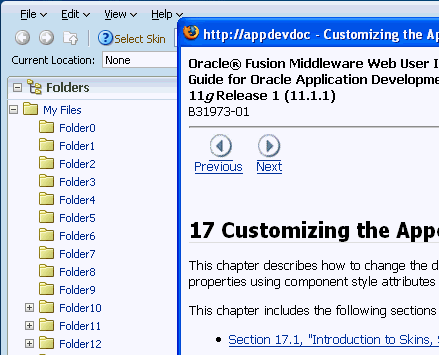| Oracle® Fusion Middleware Developer's Guide for Oracle Help 11g Release 1 (11.1.1.5.0) Part Number E14149-03 |
|
|
View PDF |
| Oracle® Fusion Middleware Developer's Guide for Oracle Help 11g Release 1 (11.1.1.5.0) Part Number E14149-03 |
|
|
View PDF |
If you have an ADF Faces application and wish to incorporate online help into your application, ADF Faces, also known as ADF Rich Client, provides an easy way to do that. You can create an online help system with help topics which are integrated with components of the application.
This chapter describes how to configure OHW-RC as a help provider, lists other ADF Rich Client help providers, and also describes how to use HelpTopicId attribute to associate help topics with your application.
This chapter contains the following sections:
Section 20.1, "Integrating Online Help With ADF Faces Application"
Section 20.2, "Registering OHW-RC as an ADF Rich Client Help Provider"
When you integrate a help topic with an ADF Faces component, a help icon (a blue circle with a question mark) appears with the component. When you click the help icon, the related help topic appears in a new window, as shown in Figure 20-1.
Figure 20-1 Help Icon in an ADF Faces Application

Integrating an online help with an application is an easy process, descibed in the following steps:
Register a help provider with your application
Create a properties file that contains the topic ID and help text for each help topic
Associate the UI components with help topics by using the HelpTopicId attribute
For more information about integrating online help with an application, see "Displaying Help for Components" section in Oracle Fusion Middleware Web User Interface Developer's Guide for Oracle Application Development Framework.
ADF Rich Client Faces includes a variety of help providers. You can use a combination of the different help providers or create your own help provider class. You can also use OHW-RC as a help provider.
You need to perform the following tasks in order to set up OHW-RC as a Help Provider in an ADF Rich Client application:
Deploy OHW-RC as a web application:
Deploy an RC application to web application server.
Note down the context-root of this deployment.
Open the web.xml file in this deployment.
Find the OHW-RC servlet instance.
Develop the jspx Web pages.
Create an ADF Faces-based Web application.
Create a jspx Web page; for some components (input*, select*, etc), where you can find an attribute named helpTopicId, specify the ID you want to display with your OHW-RC instance.
Copy the helpsets into a direcotry under your <application_root>/public_html folder. For example, let's name this directory helpsets.
Set up the adf-settings.xml file.
Navigate to your application's directory, and look for the .adf/META-INF/ directory. Under that directory you can find the adf-settings.xml file. If the .adf/META-INF directory is not present, create the META-INF directory under the ViewController/src directory.
Enter code into adf-settings.xml; for example:
<adf-settings xmlns="http://xmlns.oracle.com/adf/settings">
<help-provider>
<help-provider-class>oracle.help.web.rich.helpProvider.OHWHelpProvider</help-provider-class>
<property>
<property-name>ohwConfigFileURL</property-name>
<value>/helpsets/ohwconfig.xml</value>
</property>
<!--property>
<property-name>group</property-name>
<value>null</value>
</property-->
<property>
<property-name>baseURI</property-name>
<value>http://localhost:8989/help-ohw-rcf-context-root/ohguide/</value>
</property>
</help-provider>
</adf-settings>
In this adf-settings.xml file:
If you want to use OHW-RC as your help provider, then, in this adf-settings.xml file, the class has to be OHWHelpProvider.
Set the ohwConfigFileURL property to point to your /helpsets/ohwconfig.xml. Noe that you created the helpsets directory in Step 3.
Note:
You can also specifyohwConfigURL using the prop system property. For example, in web.xml, the ohwConfigURL would be configured as:
<param-name>ohwConfigFileURL</param-name>
<param-value>file:///{%prop}/help/ohwconfig.xml</param-value>
In adf-settings.xml, the ohwConfigURL would be configured as:
<property>
<property-name>ohwConfigFileURL</property-name>
<value>file:///{%prop}/help/ohwconfig.xml</value>
</property>
The prop property is predefined, or specified, by starting Oracle WebLogic Server with -Dprop option. For example, -Dprop=/Oracle/help.
The group property specifies the group name (which you want to use in the help provider) in your ohwconfig.xml file.
The baseURI property specifies the server host, the context root, and the OHW-RC servlet instance of the RCF application that you deployed in Step 1.
To associate a help topic with an ADF component, you must assign the help topic's unique id as the HelpTopicId attribute's value. The HelpTopicId attribute is available in the Appearance section of Property Inspector.
Before associating a help topic with a component, ensure that you have registered a help provider with your application. To register OHW-RC as a help provider, see Section 20.2, "Registering OHW-RC as an ADF Rich Client Help Provider".
For more information about HelpTopicId attribute, see "Displaying Help for Components" section in Oracle Fusion Middleware Web User Interface Developer's Guide for Oracle Application Development Framework.
Two common ADF Rich Client help providers are ResourceBundleHelpProvider and ELHelpProvider. The ResourceBundleHelpProvider help provider allows you to create resource bundles. These resource bundles are containers of your help files, control files, graphics, and other related files. The ELHelpProvider help provider allows you to create XLIFF files. The XLIFF files get converted into maps, or create a managed bean that contains a map of help text strings.
For more information about these and other help providers, see "Displaying Help for Components" section in Oracle Fusion Middleware Web User Interface Developer's Guide for Oracle Application Development Framework.